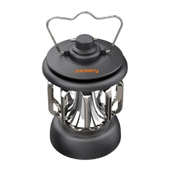North Carolina might seem like an affordable place to live in unless you look at the bigger picture. As of July 2024, the average electric bill in NC is around $147.07, which is less than in major cities, but a gradual increase, especially from last year or so, can be concerning. And you’re bound to get a shock if you don’t know what you’re doing.
Well, one of the best ways to cut off your worries and electricity bills at the same time is by investing in solar generators. Jackery Solar Generators are one of the best models that can even run air conditioners, refrigerators, and others to cut down your reliance on the utility grid.
What Is The Average Electric Bill in North Carolina?
Even though North Carolina ranks in the top 10 electricity-producing states in the nation, its average electric bill has risen steadily over the years. As per the latest U.S. Energy Information Administration (EIA) report released in 2024, consumers, with their average electricity consumption at 1072 kWh, pay around $147.07 monthly on bills.
Compared to the nation’s average utility bill ($147.52), it still is less but ranks in the top half of the state rankings in this respect. The numbers further rake up in extreme weather conditions, when most households use electricity for home heating and air conditioning.

Here’s a table of comparison between North Carolina and other major US states, alongside monthly electricity consumption, average energy rates, and respective rankings.
|
State |
Avg. Bill |
Avg. Rate |
Monthly Usage |
Ranking |
|
North Carolina |
$147.07 |
13.72 ¢/kWh |
1072 kWh |
30 |
|
Michigan |
$129.61 |
19.88 ¢/kWh |
652 kWh |
17 |
|
Utah |
$90.04 |
11.50 ¢/kWh |
783 kWh |
3 |
|
Texas |
$170.45 |
14.47 ¢/kWh |
1178 kWh |
45 |
|
Colorado |
$152.86 |
15.21 ¢/kWh |
1005 kWh |
5 |
Source: EIA
Despite charging one of the lowest prices, the average electric bill in NC is the second highest. Why? The state ranks in the top 10 states in electricity consumption and in the top 5 for residential sector electricity use. The residential sector accounts for around half of the electricity produced in NC, while the commercial and industrial sector makes up one-third and one-fifth of the total portion, respectively.
As of July 2024, the average electricity rate in North Carolina for residential usage is around 13.72 cents per kWh, compared to 10.35 cents per kWh and 7.77 cents per kWh for commercial and industrial usage. With increasing demands in the future, you must prepare to pay a chunk of your earnings on electric bills.
What Is The Average Electric Bill in Charlotte, NC?
Charlotte is one of the largest cities in North Carolina, with its population growing quickly. To accommodate the rising energy needs of people, major providers like Duke Energy and others spend billions on upgrading the infrastructure and electric grids to cause fewer outages and enable faster power restoration. These spending are passed into their bills, resulting in an increase in the average monthly bill in Charlotte, NC, from $130 to $140 in 2023, around 12% more than the state average.
Charlotte’s average residential energy rate is, however, 9% less than the state average, around 10.54 cents per kWh. However, the average energy consumption in Charlotte is 1430 kWh compared to the state average of 1072 kWh, the reason underlying its higher bills.
Similarly, the average commercial and industrial electricity rates in Charlotte currently stand at 7.96 cents per kWh and 6.05 cents per kWh. That’s around 13% and 16% less than the state average. In short, energy savings are an important factor in determining your monthly electric bill. Especially when the living costs in the city are just above the state average.
How Much Does It Cost to Live in North Carolina?
North Carolina is generally more affordable than many states, with around 4% less cost of living than the national average. Compared to major states like Hawaii, New Jersey, Milwaukee, and others, it’s much cheaper.
An average household in North Carolina pays around $282 monthly and $3,384 yearly in utility bills. That’s around 20% less than the national average of $351 monthly and $4212 yearly payments. While high, an average household in NC spends more on rent, mortgage, and insurance payments, totaling $1913.
Charlotteans, although they pay slightly less utility bills, the state still ranks in the top 25 costliest cities in North Carolina with respect to household expenses, as the new study by Doxo says. Their average monthly bills at $2190 is almost 14.5% higher than the state average and 7% higher than the national average.
An average Carolina resident spends the major portion of his rest on necessities like transportation and food and the remaining on other miscellaneous items.

According to the U.S. Bureau of Labor Statistics data, the average price of milk per gallon is $3.8 per gallon, whereas the fresh chicken price is around $1.991. The same report reveals that the average price of eggs in North Carolina is around $2.992.
Similar to food prices, you’ll have plenty of options for public transport. There are public bus systems that cost between $2-3 mostly, while the CityLYNX gold line is free. You can access its bike-share program, where a 24-hour pass costs $100.
Why Is My Electric Bill So High in North Carolina?
Most households in North Carolina see a higher electricity bill in hot summer months when air conditioners run for hours. But that might not be the sole reason why you received a high bill. These can be as follows:
Old Appliances In the Household
Electric appliances degrade and lose efficiency over time. Older ones didn’t meet the required standards as the modern ones with an Energy Star rating and consume more energy even in their prime. It can be a prime reason your pocket empties over electric bills every month.
Inefficient Use of the Appliances
Many homeowners, despite using modern appliances and not using them frequently, have complained about high electric bills. Seems unrealistic? But no. Some appliances continue to draw power even when they’re on standby. In a conventional household, it includes garage door openers, DVR systems, and smart devices like Amazon Echo, microwaves, or chargers.
The electricity consumption in standby mode might not be very high, but it slowly adds up to a high electric bill. You’ll notice that when you’re away from home but get a decent electric bill.
Enrolled On a Time-of-use Rate Structure
If your utility provider lured you into tweaking your plan by claiming that you’ll potentially save a lot but, rather, increased costs are showing up, then you’re probably on a Time-of-use or TOU rate. So, what is it? Utilities, major or minor, like Duke Energy, under this rate structure, charge different rates depending on when you’re consuming energy.
For example, during “peak hours,” or when an average population consumes more energy, Duke charges 27.65 cents per kWh, almost triple the standard rate. While in “off-peak hours,” you can get discounted rates of up to 6.8 cents per kWh. So if you’re using more power during peak hours, expect three times the electric bill this month.
Increasing Utility Rates
Electricity rates, throughout the year, fluctuate, and the residential sector typically has a higher curve. In North Carolina, the increasing population and, in turn, increasing energy demands have made Duke Energy upgrade its electricity grids, which cost it millions. And the only way to compensate for that is by charging more per kWh, which means you have to pay more for the same amount of energy you consume.
The best way out here is to go solar. Installing solar panels might seem like paying a lot upfront, but it has the potential of you saving almost double in the next decade. Besides, state and national governments have many initiatives and programs in place where you can apply to get discounts and rebates over the price. In this way, you’re not only saving more but also preserving the environment.
You can try investing in one of the most robust charging solutions out there: Jackery Solar Generators. It houses powerful batteries to power up plenty of your household appliances for hours. These are portable and suitable for your off-grid living and don’t require any heavy installation.
Jackery Solar Generators for Lowering Your Electric Bills
Jackery is one of the most renowned solar brands that manufactures and sells solar panels, power stations, and solar generators. A Jackery Solar Generator combines foldable Jackery SolarSaga solar panels and Jackery Explorer Portable Power Stations to keep most household appliances running and cut down the bills.
Now, when sun rays are incident on monocrystalline silicon cells encased inside Jackery SolarSaga Solar Panels, it converts sunlight into DC current. It is passed on to the pure sine wave inverter of the Jackery Explorer Portable Power Station, where DC converts into AC and powers up the household appliances.
Jackery Solar Generator 3000 Pro
Among Jackery's long list of products, Jackery Solar Generator 3000 Pro is one of the most popular. Its powerful NMC battery can supply steady electricity to 99% of your appliances, including space heaters, air conditioners, and refrigerators. The best part is that you can charge it using a car battery, wall charger, or even 6*Jackery SolarSaga 200W Solar Panels in 3.5 hours.

|
Solar Generator 3000 Pro |
|
|
Capacity |
3024 Wh |
|
Battery Cell |
NMC |
|
Cycle Life |
2000 cycles to 70%+ capacity |
|
Recharging Methods |
Solar Recharging: 3.5 H (6*Jackery SolarSaga 200W Solar Panels) Car Recharging: 35 H Wall Recharging: 2.4 H |
|
Output Ports |
AC Output (x1): 120 V~ 60 Hz 25 A Max AC Output (x3): 120 V~ 60 Hz 20 A Maximum USB-C Output (x2): 100 W Maximum, 5 V⎓3 A, 9 V⎓3 A, 12 V⎓3 A, 15 V⎓3 A, 20 V⎓5 A |
|
Working Hours |
Dishwasher (1500 W): 1.7 H TV (150 W): 17.1 H Hair Dryer (1800 W): 1.4 H AC (1000 W): 2.6 H Microwave (1000 W): 2.6 H |
|
Customer Review |
“Great service and great products. This is our 3rd Jackery. We've been fortunate to have solid backup power during storm outages in the last year.” — Gary Suit. |
Jackery Solar Generator 2000 Plus
Jackery Solar Generator 2000 Plus encases a LiFePO4 battery, best known for its expandability to up to 24 kWh. Just add another unit to it, and charge most of your household appliances (big or small) for a long time. It seems like a great option if you’re looking to offset your electric bill. And the wheels at the bottom make it easy to carry around.

|
|
Solar Generator 2000 Plus |
|
Capacity |
2-24 kWh |
|
Battery Cell |
LiFePO4 |
|
Cycle Life |
4000 cycles to 70%+ capacity |
|
Recharging Methods |
Solar Recharging: 2 H (6*Jackery SolarSaga 200W Solar Panels) Car Recharging: 25 H Wall Recharging: 2 H |
|
Output Ports |
AC Output (×4) 120 V~ 60 Hz, 20 A Maximum AC Output (×1) 120 V~ 60 Hz, 25 A Maximum USB-A Output (x2): Quick Charge 3.0, 18 W Maximum USB-C Output (x2): 100 W Maximum, (5 V, 9 V, 12 V, 15 V, 20 V up to 5 A) |
|
Working Hours |
Dishwasher (1500 W): 1.2 H TV (150 W): 11.6 H Hair Dryer (1800 W): 1 H Water Heater (1125 W): 1.5 H Microwave (1000 W): 1.7 H |
|
Customer Review |
“Very good quality, the battery lasts a very long time. Very easy to move around with the built-in tires. Love the upgradeability. The best solar generator I have ever had.” — Marc. |
Jackery Solar Generator 2000 Plus Kit (4kWh)
The Jackery Solar Generator 2000 Plus Kit (4kWh), similar to others with its powerful battery and ability to charge most appliances, can waive most of your average electric bill in NC. What’s different is what’s encased inside. There are 1*Jackery Battery Pack 2000 Plus, 1*Jackery Explorer 2000 Plus Portable Power Station, and 2*Jackery SolarSaga 200W Solar Panels.

|
|
Solar Generator 2000 Plus Kit (4kWh) |
|
Capacity |
2-24 kWh |
|
Battery Cell |
LiFePO4 |
|
Cycle Life |
4000 cycles to 70%+ capacity |
|
Recharging Methods |
Solar Recharging: 2 H (6*Jackery SolarSaga 200W Solar Panels) per unit Car Recharging: 25 H per unit Wall Recharging: 2 H per unit |
|
Output Ports |
AC Output (×4) 120 V~ 60 Hz, 20 A Maximum AC Output (×1) 120 V~ 60 Hz, 25 A Maximum USB-A Output (x2): Quick Charge 3.0, 18 W Maximum USB-C Output (x2): 100 W Maximum, (5 V, 9 V, 12 V, 15 V, 20 V up to 5 A) |
|
Working Hours |
Dishwasher (1500 W): 2.4 H TV (150 W): 23.1 H Hair Dryer (1800 W): 1.9 H Water Heater (1125 W): 3 H Microwave (1000 W): 3.4 H |
|
Customer Review |
“I’m impressed with the quality and design (even the packaging) of the Jackery products and am looking forward to replacing a gas-guzzling generator(s). One unit feature that I particularly like is the expansion capabilities..well done, Jackery.” — Randall MacPherson. |
How to Lower My Electric Bill in North Carolina?
Here are some easy ways to reduce high electricity bills in North Carolina.
Upgrade The Appliances
Check your houses for old appliances that are energy hoggers and upgrade them to ones with Energy Star ratings. This holds true for dryers, air conditioners, refrigerators, and dishwashers that hog most of your energy. You should notice the savings in the very first month of the upgrade.
Use the Appliances Efficiently
Clean the appliances, especially air conditioners, dishwashers, refrigerators, etc. With more debris or dust on your appliances, they tend to be less efficient. You can also attach smart power strips to these appliances. What they do is completely power off the system, thereby minimizing energy consumption.
Consume Energy Smartly
If you can’t opt out of the TOU plan, try consuming energy smartly. If you don’t work much during off-peak hours, take some time to think if you can adjust or change your habits. Start small by scheduling the runtime for appliances like dryers and dishwashers. You can also charge EV vehicles during these hours. In this way, you can save a few dollars every month.
Use Jackery Solar Generators
As mentioned, investing in solar energy is beneficial, not only financially but also environmentally. And not many are better alternatives to solar generators to keep your household devices up and running.
Jackery Solar Generators, with their excellent capacity, can cut down over-reliance on the electrical grid to run your appliances. The bigger ones, like Jackery Solar Generator 3000 Pro and Jackery Solar Generator 2000 Plus, can charge and run 99% of your appliances, so they turn a viable companion during a power outage and save a chunk of your salary.
North Carolina Average Electric Bill FAQs
What size of solar generator do I need for my house in North Carolina?
The apt size of a solar generator in your house in North Carolina depends on the number of appliances, hours they are running, and in turn, total wattage consumption.
Let’s understand it with an example:
Consider you have an air conditioner (1000 W), a TV (150 W), and a mini-refrigerator (400 W) running simultaneously on Jackery Solar Generator 3000 Pro. The number of hours they’ll run is calculated using the formula:
Working Time = Battery Capacity * 0.85 / Operating Wattage of Appliances = 3024 Wh * 0.85/ 1550 W = 1.65 H.
We have multiplied by 0.85 since there will be some power loss while charging appliances.
What is the average utility bill in NC?
The average utility bill in NC, as per EIA, is $147.07 per month and $1764.84 per year.
|
Utility |
Avg. Bill |
|
Energy Bill |
$147.07 |
|
Gas Bill |
$103 |
|
Water Bill |
$20 |
|
Internet Bill |
$35 |
How much is an electric bill in Charlotte, NC?
The average electric bill in Charlotte, NC, as of 2023, is $140 per month.
What state has the highest average electric bill?
Hawaii, with an average energy rate of 42.45 cents per kWh, has the highest average electric bill in the country, at around $218.61 per month.
What uses the most electricity in a home?
Cooling and heating appliances like refrigerators, air conditioners, heaters, and others consume the most electricity in a residential space.
Final Thoughts
Electricity bills in North Carolina are on the rise for various reasons, and merely upgrading or maintaining appliances won’t make much difference. It’s time to take a big step and invest in solar power.
Jackery Solar Generators use sunlight to generate AC current to run most of your appliances and save more on average electric bills in NC in the long run. These generators come with Jackery Explorer Portable Power Stations, so you can store the charge and use it while traveling or when there’s a power outage.












































































































![What Is The Average Electric Bill in North Carolina [2024 Updated]](http://www.jackery.com/cdn/shop/articles/average_electric_bill_in_nc_by_jackery.jpg?v=1712718631)







Leave a comment